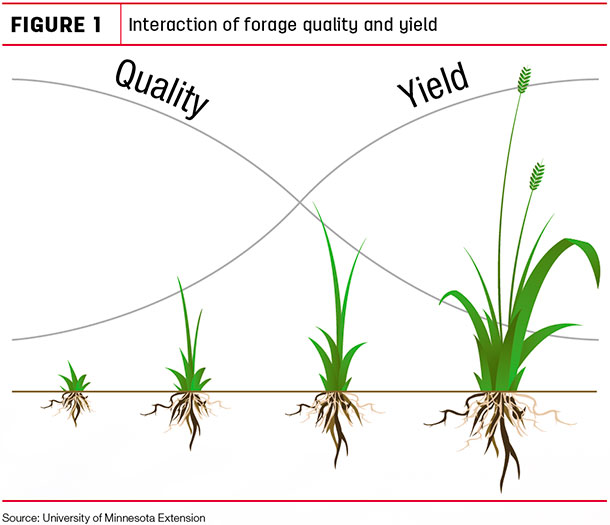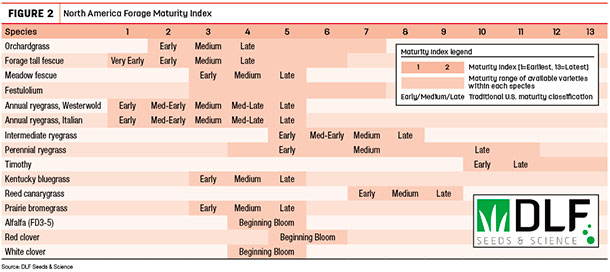One major challenge to producing high-quality forage from cool-season grasses is their relatively short harvest window because forage value can decline rapidly in a relatively short amount of time. As forages approach maturity, dry matter increases at the expense of forage quality (Figure 1).

To manage this challenge, breeders have worked to widen maturity ranges. Consequently, producers began growing grasses exhibiting a wide range of maturity stages or schedules.
Orchardgrass
In recent studies at the University of Vermont, more than 30 orchardgrass varieties and over 50 timothy varieties tested showed a wide range in maturity. For instance, over a two-year span, the orchardgrass varieties tested differed in their “heading date” – defined as the date when a grass has at least five tillers in the early head stage – by a whopping 40 days. Timothy maturity differences spanned over 30 days.
Selecting the proper maturity of grasses paired with legumes is very important when managing for yield and quality. Consider orchardgrass, which is commonly paired with alfalfa or other legumes either at planting or even one to two years after seeding.
This is usually done to increase forage tonnage, ease silage and grazing systems, and help deliver more consistent production through the year, with the potential benefit of extending stand life.
When pairing orchardgrass with alfalfa, it is imperative the maturity of the grass coincides with the cutting schedule and, to some degree, the fall dormancy of the alfalfa variety. Fall dormancy is a measure of how quickly alfalfa enters and breaks dormancy in fall and spring, and correlates with how quickly it recovers after each cutting.
A higher fall dormancy rating indicates less-dormant alfalfa, which equals less time between cuttings, and that greatly impacts the management requirements of the producer.
The last thing a producer wants to see is orchardgrass headed out in the spring two to three weeks or more prior to the alfalfa being ready to harvest. Potomac orchardgrass is a common variety that has been around a long time. Likewise, many older varieties of orchardgrass tend to be early maturing. Recent breeding efforts have yielded new varieties that offer a wide range of maturity times, as revealed in the Vermont study.
Timothy
Timothy is another commonly used cool-season species, and usually earlier-maturing varieties are preferred. It is hard to believe the most commonly used Climax variety was first identified in the early 1700s. Many familiar traditional timothy varieties are even later in maturity.
Research and breeding with timothy in the last 20 to 30 years has brought many new, earlier-heading varieties to the market. But even earlier-maturing varieties of timothy are not comparable in timing to alfalfa, or many other grasses for that matter.
Perennial ryegrass
Another species to consider is the “queen of forage grasses” – perennial ryegrass. Perhaps not as well-known, perennial ryegrass can also vary greatly in date of heading. In areas of the country where perennial ryegrasses thrive, it is crucial for producers to time their grazing cycles or harvest schedules correctly based on their forage goals.
If tonnage is the objective, it may make more sense to plant an earlier variety, assuming the grower can capture that growth in an opportune manner. Ryegrass is widely known for its overall quality. However, if an earlier-maturing variety is planted and not monitored closely, quality will be greatly diminished. Later-maturing options offer increased harvest flexibility but may compromise yield.
Management styles
Forage grasses make a ton of sense with producers across the country. With the relatively newer relative forage index becoming more common as a means of evaluating forage quality, the value of quality grasses becomes clear, even compared to alfalfa. In the past, forage grasses were considered inferior to legumes due to their higher neutral detergent fiber levels.
However, fiber in grasses is typically more digestible than fiber in legumes like alfalfa – and relative forage index measurements take this into account. It is another reason to look at forage grasses, even in hay production systems.
Like many things, however, it comes back to the producer and how the farm is managed. Spreading out maturities of perennial grasses lessens risk and workload, and ensures grasses are given the opportunity to reach their highest quality.
However, when forage composition becomes too intricate or even convoluted in the field, it can lead to increased complexity when it comes to dialing in the correct timing for fertilizer applications, grazing cycles and harvest schedules. Understand your expectation and pick your varieties accordingly.
The takeaway is clear: Consider the production and management goals, and then match the varieties accordingly. If your forage seed supplier cannot tell you the maturity of the products they offer, it probably means they are not too serious about selling a sound solution.
Consider Figure 2, which highlights work in the industry to help make purchasing decisions easier for producers today, along with this quote from DLF Seeds and Science: “... traditional nomenclature of early, medium and late is no longer effective in classifying and comparing the relative reproductive maturity of varieties within a species.

A producer attempting to select a correct variety for his or her operation is challenged to compare the maturity of varieties among different forage grass companies. Additional challenges arise when comparing reproductive maturity between species. Interspecies correlation is lacking. An ‘early maturity’ variety in one species may actually be chronologically later in maturity than a ‘late-maturity’ variety in another species.” ![]()
PHOTO: Thinning alfalfa stands are perfect candidates for introducing perennial grasses. Be mindful to select grass maturities that match the alfalfa and management system. Photo by Scott Wohltman.
Scott Wohltman is a certified crop adviser with La Crosse Seed. Email Scott Wohltman.












